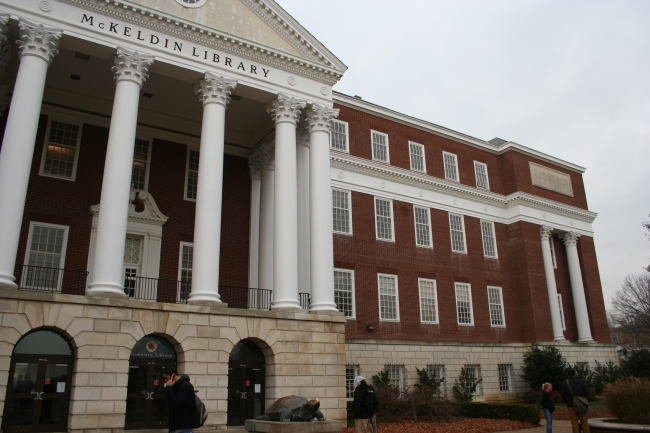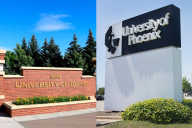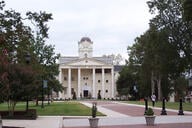You have /5 articles left.
Sign up for a free account or log in.

The University of Maryland's College Park campus, in the suburbs of Washington, D.C.
David Tansey
When the University of Maryland at College Park joined the Big Ten Conference back in 2014, the move signaled an era of new possibilities for the university.
But it also meant that the resources it lacked -- like a medical school -- would become more apparent than ever.
Now, the university hopes to grow. If proposed state legislation goes through, the College Park campus will form a “strategic partnership” with the University of Maryland at Baltimore, which houses seven professional schools.
They’re separated by 30 miles: at the College Park campus, 30,000 study in the Washington, D.C., suburbs. At the Baltimore campus, 6,000 graduate students study medicine, law, psychology and other graduate topics.
“It feels like the difference between New York and California,” said Geoffrey Heinzl, student government president at the Baltimore campus.
The plan’s proponents pitch the institutions’ differences as an asset: the idea, they say, is to strengthen two disparate campuses by helping them work together.
“In a partnership, one plus one does not equal two,” College Park President Wallace Loh said at a legislative committee hearing Tuesday. “One plus one can equal three or four.”
But the plan’s critics -- mostly in Baltimore -- worry that the partnership will harm their comparatively smaller operation. They say the plan was designed to increase the flagship campus’s status, and they worry it will become a de facto merger.
Called a strategic partnership, the plan allows each campus to keep its president and personnel system. At the same time, they will become a unified University of Maryland, sharing resources and reporting data together in national rankings.
For many, it’s a question of dominance: While members of a university system may work together, should they ultimately have different missions? What happens when there’s an imbalance of power?
“When you have a campus with six times as many students as the other,” Heinzl said, “that campus would very likely rise to the top of the priority list.”

At the system’s ten other campuses, that concern is equally worrisome. If the College Park campus grows, will the other campuses lose power?
Most of the system’s students -- 70 percent -- attend one of the ten remaining campuses. Some wonder whether College Park’s growth will lead to a loss of status at other campuses, and others wonder why they aren’t able to reap the benefits of a high-profile partnership.
That’s particularly true for the University of Maryland Baltimore County, located just 10 minutes outside the city. “I just feel like UMBC is being left out of this,” State Delegate Mark Chang said at Tuesday’s hearing.
But UMBC’s mission is different, said Senate President Thomas V. Miller Jr., who’s been a prominent supporter of the bill. The partnership would be a win-win for the entire system, he added, boosting its standing among its peers.
“Why does every single one of our peer institutions have the professional schools aligned with the flagship?” he said. “Because it makes sense.”
Without professional schools, it’s also harder for Maryland to compete with the other Big Ten institutions in the rankings. Almost immediately, the partnership would give the university’s ranking in research spending a significant boost.
“Rankings are important at some level,” said Jordan Goodman, chair-elect of the University Senate. If the two Maryland campuses combine resources, “that puts us at the very top.”
But rankings, opponents say, aren’t enough to justify a merger. They argue that the two campuses can collaborate through their existing agreement, and that the rankings boost will mean much more to College Park than to UMB.
What’s in a Merger?
Several years ago, Maryland regents rejected a proposal to merge the two institutions. Instead, the campuses entered into a collaboration, known as MPower. The new plan codifies MPower, officially combining the two campuses under one umbrella university. But as the plan's supporters point out, the word “merger” never appears in the bill.
“A merger would mean we really are one institution, with one set of leaders and one personnel system,” said a College Park spokesman, Brian Ullmann. “This strategic partnership keeps both institutions independent.”
The new plan’s boundaries are precarious: to placate those on both sides, it must walk a fine line, existing somewhere between collaboration and merger.
In some cases, it’s working. William E. Kirwan, former chancellor of the Maryland system, was against the 2011 merger. But because the new plan allows for two presidents, he supports it.
“It codifies the partnership between these two institutions,” he said. “The partnership that currently exists is dependent upon the goodwill of the two presidents.”
Yet the language is important. At Tuesday’s hearing, many worried that the plan is a merger disguised as a partnership: What does a strategic partnership really mean? And if it can’t be defined, is it significantly different from a merger?
“I am very supportive of amendments that would clarify that this is a strategic partnership,” Jay Perman, president of the Baltimore campus, said at the hearing.
“From a legal perspective, this is something that needs to be clarified throughout,” said the system's chancellor, Robert Caret.
The legislation is still evolving, and so far many of the changes have emphasized UMB’s autonomy. In an earlier version, the legislation called for one president who would oversee both campuses. The provision worried some in Baltimore, who thought it would make it harder to prioritize the smaller campus and the surrounding city.
But in more recent versions of the plan, the provision has been removed, and UMB will keep its president. The system's headquarters will also move to the city.
Yet many still worry about the Baltimore campus. The university plays a big role in the community, and its service work supports the city’s impoverished. Critics say the partnership could weaken those efforts.
Baltimore, after all, is a city of 600,000, which was thrown onto the national stage last spring amid a series of protests over racial tensions and police violence. College Park is a suburb of 30,000, the second-to-last stop on the D.C. metro’s green line.
“We have a lot of connection to Baltimore City,” said Sarah Michel, president of the UMB Faculty Senate. “We worry that, if we’re merged with College Park, that we will have less of that energy and enthusiasm.”
But in many ways, the plan’s supporters say, the two locations are more alike than different, and the partnership could strengthen service work in both locations.
“College Park is the flagship land-grant university of the state,” Ullmann said, “and we embrace a mission of service to the entire state.”
Stephen Thomas, a professor in the School of Public Health, has spoken multiple times about public health conditions in the two locations: Prince George’s County -- where College Park is located -- and Baltimore City have some of the worst health statistics in the country. In College Park, the public health program has set up a network of health information portals through barbershops that serve African-Americans. Black barbershops have a long history in Baltimore, Thomas said, and it makes sense to expand the program into the city.
But couldn’t that work be done under the current partnership, critics ask? Supporters say no: the current partnership is informal, thriving mainly because of the strong relationship between the two presidents.
“If we both had a heart attack tomorrow, there is no guarantee that this partnership would continue,” Loh said at Tuesday’s hearing. “Partner and flourish. Don’t partner and perish.”
Andrew Horn, a College Park student, has heard Loh make similar statements, and they struck him as rather stark. Even if a partnership would increase research dollars, is the system in such trying circumstances?
“I just want to get your feel,” Horn asked Perman at a recent town hall meeting. “Is it really that dire?”
Perman, in good humor, said no. “I don’t feel death coming over us.”




